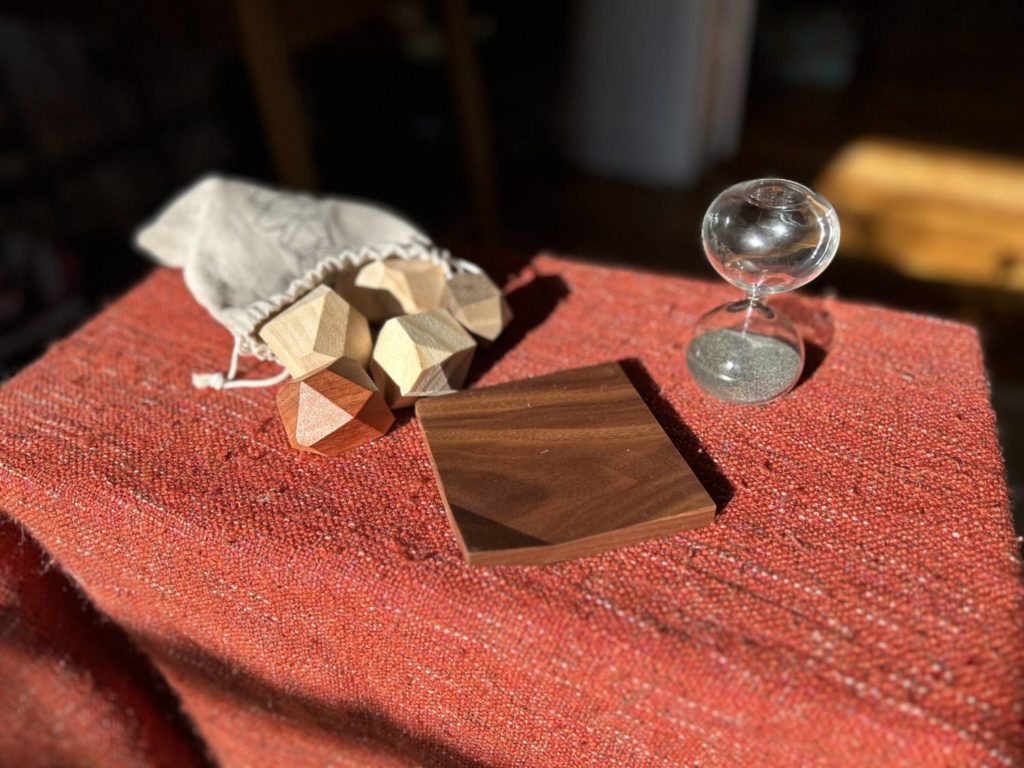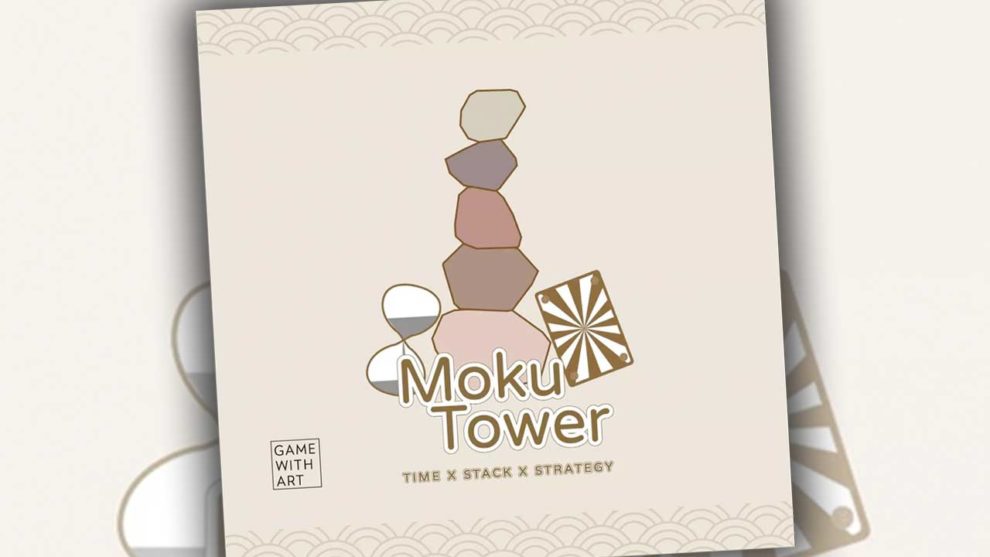Disclosure: Meeple Mountain received a free copy of this product in exchange for an honest, unbiased review. This review is not intended to be an endorsement.
Moku Tower is, without question or qualification, the most striking review copy I’ve ever received. There’s something here for all the applicable senses (Taste has, lamentably, been yet again neglected by the board game publishing industry).
For the eyes, a veritable cornucopia. The box is handsome. A slight lip separates the top from being flush with the bottom. Inside, there’s an onion-bulb glass timer filled with black sand, a dark wooden base with one cheekily raised corner, and a cloth bag for holding the pieces, which come in a cardboard tube. The pieces themselves, asymmetrical chunks of wood, have varied grains and colors. As you can see from the photographs, to call Moku Tower “photogenic” is to do it a disservice.

Something pictures can’t capture: the smell upon opening the tube is divine. Each piece is made from a different type of wood. The combined scents of ash, birch, camphor, maple, pine, rosewood, sapele, and walnut mingle into an intoxicating blend.
All the while, you experience the tactile joy that sits at the core of this hobby. The box is made of thick board. The timer is heavy for its size. The wooden shapes make you feel like a particularly sophisticated toddler, a toddler from a Land’s End catalogue.
Even the ears are delighted as you mess around with the components. You can hear the sand in the timer rush into the bottom bulb, hitting against the glass. The wooden pieces are solid, resonant, delightfully clacky. As an object divorced of function Moku Tower is a triumph. We should all be so lucky.
Aestheticism
If I devote all my energies here to describing the aesthetic experience of Moku Tower, rather than delving into the game itself, that’s because the aesthetic experience is really all Moku Tower has going for it. As a design, it falls flat. So to speak.

This is, as you may have guessed between the planed nature of the shapes and the conspicuous use of the word “tower” in the title, a stacking game. On your turn, you flip over the timer and draw a card. The card tells you the pieces you need to stack, and in what order you need to stack them. Once that mischief is managed, you have the option to draw extra cards that prompt you to add additional shapes to the tower. Other players have cards that interfere in various ways. Use one hand, things like that.
That sounds straightforward enough, but Moku Tower manages to be simultaneously too straightforward and unwieldy. The wooden pieces are shaped in such a way that each piece comes to have what we can think of as a solved position, an objectively correct way to place it. Once you’ve played a couple of times, you have those memorized. You would think that the unusual angles lead to space for exploration, inviting novel placements based on shared angles, but the wood is so smooth that pieces don’t grip one another. If the angle isn’t a certain degree of flat, the pieces aren’t staying. Your best bet is finding these solved positions.
Ironically, Moku Tower‘s biggest problem ties in to the game’s aesthetics. To play, you have to know what type of wood each piece is. This is no small feat. There’s no varnish to bring out the colors and grains, these are naked pieces of wood, and, as such, they are indistinguishable. While designers Louis Hsu and Ivan Kan were thoughtful enough to include guide cards to set the pieces on, the sizes of the illustrations on each card don’t seem to correspond to the relative sizes of the pieces. If the drawings and the blocks are meant to correspond by size, then the color matching on the illustrations is horrible. Unless someone in your circle is a carpenter, you’re going to be lost.

Would it have been such a compromise to include some sort of marking on each piece of wood? I feel like that would have been fine. This is the kind of thing that had to have come up in testing. How does it get this far? I do not know.
What I do know is this: I’ll not be playing Moku Tower again. I will, however, be keeping it as a handsome bit of table decor, which is to some extent all I think it ever really wanted to be.
If you’d like to purchase a copy of Moku Tower for 10% off, you can do so through the publisher’s web store, using the code SUMMER10.












Add Comment